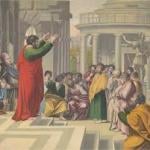The critical approaches to scripture that acknowledge different levels of meaning to a text affirm the possibility for ordinary persons to use scripture and discover valid meaning in the text. In the spiritual use of the text, we are not trying to understand the mind of the author, but the meaning of the text as it now presents itself to us with our given set of experiences and questions. Critical approaches to interpreting the Bible affirm that anyone who comes to scripture as a believing member of the community shaped by the Bible can find some personal meaning from the text that is valid, even though it may not be the meaning intended by the author.
Spiritual directors who encourage the use of scripture in prayer, but who are not professional exegetes themselves, still carry the responsibility of being biblically informed and aware of the discoveries that professional exegetes are making. The same holds true for directees who use scripture for prayer. This means that all of us ought to have some grasp of what contemporary scholarship is saying about the various books of the Bible, and not hesitate to consult commentaries to have a fuller understanding of the texts we use. Our critical knowledge of the Bible is not a stumbling block to praying with scripture; rather, this knowledge is a valuable support and supplement to our praying with scripture with the imagination.
David Stanley's A Modern Scriptural Approach to the Spiritual Exercises is a good example of the contribution critical biblical scholarship can make to the use of scripture in prayer. This work makes the meaning of selected texts used in conducting the Spiritual Exercises more available to us and helps us keep the personal meanings we discover in line with what the text allows.
While David Stanley's work helps us step back into the world of the text, we still need to find our way back to our own world with the power of God's word for us now. Only in this way will we be able to experience the living God of today, and not just the God of the world of yesterday. This means that the person praying those texts needs to become imaginatively involved in them. Through imaginative play in the story, the pray-er sees herself or himself personally related to the living God, and can experience the transforming effect the story has to release hidden energies for loyalty and trust as a contemporary disciple of the Lord.
Imagination and Scripture
To say we must be able to approach the biblical text in prayer with the imagination means that we need to be able to pray with the text as left-handed thinkers. Left-handed thinking uses intuition, feelings, and imagination. Right-handed thinking uses logical reasoning and analysis. Right-handed thinkers exegete a text for its literal sense. Left-handed thinkers participate in the story and let the story grasp them and bring meaning to their lives. A left-handed thinker gets involved in the story as an active participant in its action and so allows the characters, emotion, and scene to mediate God. A right-handed thinker stands outside the story as a scientific observer trying to discover what really happened. But what really happened and what the human author intended in the text are of secondary interest to the left-handed thinker when praying with a text. Historical criticism supplements and supports the initial entry into the text through the imagination.
But too many still mistrust the imagination for fear that it ushers us into the world of illusion. "Give us the real world," they say, "the world of hard facts and clear and distinct ideas." Those who want solid rock under their feet think that imagination is for fantasy, and that it is the source of error and deception. To bring the imagination into spiritual disciplines, then, would only give spirituality a bad name. And to say that the imagination is our most important capacity for prayer would be irresponsible. After all, does not the imagination lead to "bad" thoughts, and bad thoughts to sexual fantasies, and sexual fantasies to distractions in prayer, and maybe even sin? So if imagination leads to sin at worst, or distractions at best, why encourage the use of the imagination in prayer?
Certainly imagination can lead to fantasy, illusion, and sin. But it can also lead to grace. We encourage the use of the imagination in prayer because it gives us access to many levels of truth. The imagination is our capacity to see through the obvious to the reality lying beneath. The imagination does not separate us from the facts, but helps illumine the facts so that we can see more than meets the eye. The imagination sees with the heart. For this reason, the most effective approach to the biblical story for spiritual growth is not an intellectual grasp of concepts about God or Jesus, but the imaginative play between the text and our experience through which we come to know God and Jesus with our hearts.




